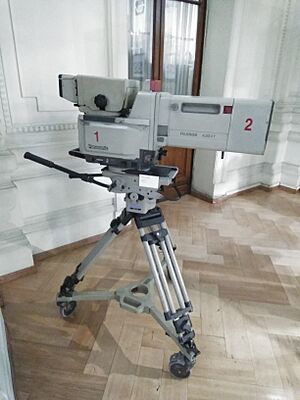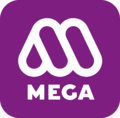Mega (Chilean TV network) facts for kids

"Se siente bien"
|
|
| Country | Chile |
|---|---|
| Programming | |
| Language(s) | Spanish |
| Picture format | 1080i HDTV |
| Ownership | |
| Owner | Mega Media (Bethia) |
| Sister channels | Mega 2 Mega Ficción |
| History | |
| Launched | 23 October 1990 |
| Former names | Megavisión (1990–2001) |
| Availability | |
| Terrestrial | |
| Digital VHF | Listings may vary |
Mega is a popular TV channel in Chile. It's officially called Red Televisiva Megavisión S.A. Mega is owned by a company called Mega Media, which is part of Bethia.
Mega started broadcasting on October 23, 1990. It was the very first private TV network in Chile. It began on channel 9 in Santiago, taking the place of another channel called Señal 2. Mega is also part of several important TV groups, like the Asociación Nacional de Televisión.
Contents
Mega's Beginnings: 1990–1992
Mega, then known as Megavisión, had a special preview night on October 23, 1990. They showed a sneak peek of their programs and a movie called Oliver. The new studios were opened in Santiago, with the President of Chile, Patricio Aylwin, and the channel's owner, Ricardo Claro, attending.
The channel officially started broadcasting the next day, October 24, 1990. At first, it only reached the Santiago and Valparaíso areas. Their first news show, Meganoticias, aired at 1:00 p.m.
In its early days, Mega didn't have many viewers. But things changed when they started showing popular TV shows from Televisa, a Mexican company. They also got the rights to broadcast important sports events. These included the Chilean National Tournament and the Copa Libertadores de América.
Mega quickly grew its reach across Chile. By mid-1991, its signal reached cities like Talca and Concepción. By the end of that year, over 85% of Chile could watch Mega.
Growing Stronger: The Mid-1990s (1993–1999)
In 1991, Televisa bought a part of Mega, owning 49% of the channel. This led to new shows being made together, like Siempre en Domingo. However, Televisa's share in Mega decreased over time. By 1999, the Claro Group owned the channel completely again.
In March 1992, Mega added more shows to its schedule. These included Happening with ja and Accompáñeme with Julio Videla. A children's show from Peru called Nubeluz also became very popular in the mornings.
In 1993, Mega and Televisa won the right to broadcast the Viña del Mar International Song Festival. This was a big deal because another channel, Televisión Nacional de Chile, used to broadcast it. The festival's host, Antonio Vodanovic, even moved to Mega to continue hosting. Mega also showed the Copa América soccer tournament that year.
The 1994 Viña Festival was the first with Televisa as a co-producer. This helped bring famous artists like Plácido Domingo to the festival. Mega also broadcast the IMSA GT Championship car races. During this time, Mega became one of the top three channels in Chile for viewers.
In 1995, Mega kept the rights to broadcast the Spanish soccer league. This was important because Iván Zamorano, a famous Chilean player, was playing for Real Madrid at the time. Mega also showed the IndyCar Series races.
Mega launched its first website during the 1996 Viña del Mar Festival. People could watch the event online, which was very new then. Mega also won the rights to broadcast the Viña Festival again until 1999. The channel started a new company to make its own TV shows, especially soap operas. In 1996, Mega also broadcast the 1996 Summer Olympics for the first time. They also showed the 1998 World Cup qualifying games for the Chilean soccer team.
For kids, Mega started showing the original Dragon Ball in 1997. It was very popular, so they also aired its follow-up series, Dragon Ball Z and Dragon Ball GT.
Mega's own TV shows started airing on March 10, 1997, with a soap opera called Rossabella. It did well in the afternoon. However, another show, Santiago City, was not as successful and was taken off the air early. The next year, A Todo Dar did much better. By the end of 1999, Mega decided to stop making its own soap operas for a while.
Popular Shows on Mega
Mega broadcasts many different types of shows. Here are some of them:
- Más vale tarde: A talk show that airs late at night.
- Morandé con compañía: A fun variety show with different acts.
- Mucho gusto: A morning show, like a breakfast TV program.
- Meganoticias: Mega's daily news program.
- Megadeportes: A daily show about sports.
- El tiempo en Mega: A show that tells you about the weather.
Mega's Slogans
Mega has used many different slogans over the years:
- 1990–1991: El otro canal (The other channel)
- 1991–1992: Megavisión, estamos con usted (Megavision, we are with you)
- 1992–2001: Megavisión, mucho que ver (Megavision, much to see.)
- 2001–2010: Mega, ¡Se Vive! (Mega, It lives!.)
- 2010–2013: Mega, ¡me gusta! (Mega, I like it!)
- 2013–2015: Mega, cambia contigo (Mega, changes with you.)
- 2015–2018: Mi Mega (My Mega)
- 2018–2020: Tú nos inspiras (You inspire us)
- 2020–2022: Comparte (Share it)
- 2022-present: Se siente bien (It feels good)
Logos
See also
 In Spanish: Mega (canal de televisión de Chile) para niños
In Spanish: Mega (canal de televisión de Chile) para niños








